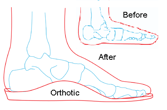
Comfort Stride is about helping you keep your feet healthy and pain-free. Our Chiropodists offer a wide range of services to help you deal with problems, injuries, deformities and issues stemming from arthritis, diabetes or any other systemic illnesses that cause problems with your feet. Here’s a quick overview of the problems we can address and the services we provide.
Please note: services are not covered under OHIP. Ontario Works and Ontario Disability Support Program recipients may be eligible for custom orthotics and/or corrective foot wear. Covered by Veteran’s Affairs Canada and Non-Insured Health Board.
Ankle Sprains
Injuries to the ligaments of your ankle joint can happen when your ankle has been forced beyond its normal range of motion. A Grade I sprain involves minor ligament stretching, Grade II moderate to severe stretching, and Grade III a complete ligament tear. Sprains can be diagnosed and treated by the chiropodist; contact the office as soon as possible to minimize further damage, and in the meantime, follow PRICE guidelines:
- Protect the joint with a splint or brace
- Rest the joint, avoid putting weight on it
- Ice the injury
- Compress with a tensor wrap
- Elevate to reduce swelling
Arthritis
If you have arthritis or bursitis in your feet, we will evaluate your joints and may recommend anti-inflammatory medications, custom orthotics and/or shoe changes and surgery as needed.
Athlete’s Foot
If your feet are cracked, blistered, itchy, red or scaly, most notably in the creases between your toes, you may have athlete’s foot, a fungal condition contracted in public areas like locker rooms. When your itchy feet aren’t responding to over-the-counter antifungal products, we will diagnose the problem, prescribe medication to get rid of your athlete’s foot, and offer prevention advice that will help your feet stay healthy and itch-free in the future.
Corns And Calluses
Thick, hardened layers of skin, caused by tight-fitting shoes or a biomechanical foot fault, can be uncomfortable and unattractive. We will remove corns and reduce calluses quickly and easily, and offer self-care recommendations and footwear advice to help you keep your feet comfortable and looking great.
Custom Orthotics
These custom-made prescription medical devices are placed inside your shoes to correct the mechanical joint and muscle dysfunction that contributes to foot pain. They are also used to treat and prevent injury-causing motions such as excessive pronation (rolling in) supination (rolling out) and to help make standing, walking and running healthier and more efficient.
Genuine custom orthotics start with a thorough exam, a cast of your feet using plaster of paris or a 3D scan, and a detailed prescription form, which are all sent to a professional lab. Some clinics use a computerized force platform to get impressions, which are then used to modify a pre-manufactured insole. These are not true custom orthotics – if there’s no cast, a complete impression of your foot has not been taken, and you don’t get the full benefit.
Our Chiropodists do all fittings for orthotics. Chiropodists train more extensively in the function, biomechanics and orthotic manufacturing than any other foot care practitioner; when they make orthotics, you know they’ll fit right.
Diabetes Care
For diabetics, we recommend regular foot care, with frequency depending on the seriousness of your condition, and on the extent to which you are able to care for your feet yourself. He will examine your feet on a regular basis, and recommend treatments to help maintain your foot health – and your overall well-being.
Please note: If you have cuts, wounds or other injuries to the feet, call us immediately. Do not wait to see if things heal on their own; with diabetes, there’s a good chance that the condition will get worse, and it’s easier to treat it earlier than if it progresses into an infection.
Read more about our foot care services for patients with Diabetes.
Flat Feet
When the arch on the inside of your foot is flat, allowing your entire sole to touch the floor, you may have flat feet. It’s pretty common and usually painless, though you may experience pain in your arches when you walk. Flat feet can be caused in childhood if arches don’t develop, or can be a sign of age-related wear and tear. We will examine your feet and prescribe orthotics if needed.
Fungal Nail
 Also known as onychomycosis, fungal nails are an infection of the bed and plate under the nail surface. It’s caused by fungus, which thickens and discolour the nail, makes it smell unpleasant, and can cause pain when you’re wearing shoes. The infection can spread to other nails, skin and even fingernails. It’s a common problem, and can be treated with a prescription fungicidal solution. To prevent fungal toenails, keep your feet clean and dry, wear shoes in public areas, change your socks daily, put on shoes and socks that breathe, avoid nail polish, and use a quality foot powder with talcum or an anti-fungal agent.
Also known as onychomycosis, fungal nails are an infection of the bed and plate under the nail surface. It’s caused by fungus, which thickens and discolour the nail, makes it smell unpleasant, and can cause pain when you’re wearing shoes. The infection can spread to other nails, skin and even fingernails. It’s a common problem, and can be treated with a prescription fungicidal solution. To prevent fungal toenails, keep your feet clean and dry, wear shoes in public areas, change your socks daily, put on shoes and socks that breathe, avoid nail polish, and use a quality foot powder with talcum or an anti-fungal agent.
High Arches
When you have high arches, less of the plantar surface of the foot ends up bearing your weight, which increases the stress on your heel and the ball of your foot. Also, feet with high arches aren’t able to absorb as much shock from walking and running, so it ends up being transmitted up your leg into your ankles, knees, hips and back, causing pain. Toes may deform into a claw-like shape, causing painful corns and calluses. You may benefit from the arch support offered by custom orthotics; it can help take the pressure off and increase your overall comfort. Talk to us about the best option for your feet.
Read more about our high arches treatment options.
Ingrown Toenails
One of the most common problems we see in our foot clinic, ingrown nails, can be caused by wearing shoes that are too tight in the toe and/or not cutting your nails straight across. They are uncomfortable and if left untreated, can cause severe pain. We will recommend treatment based on the severity of the infection, including water and salt soaks, antibacterial ointment, splints or surgical treatments.
Read more about our ingrown toenails treatment options.
Morton’s Neuroma (Pain Of Your Fore-Foot)
Caused by tight-fitting footwear or abnormal forefoot alignment, Morton’s Neuroma is the growth of a nerve or benign tumor due to irritation of nerve cells. Usually found between the third and fourth metarsal heads, it’s characterized by numbness, pain or a burning sensation or the blanching of the toes. We can recommend better footwear, metatarsal head support or cortisone injections. In some cases, surgery may be required.
Orthopedic Shoes
Orthopedic shoes are footwear verified by a medical professional to be wide enough and deep enough for your foot, and can be made to accommodate any pain or deformity.
There are three types of orthopedic shoes: off-the-shelf models, custom modified shoes and custom shoes. Check with your insurer to see what they cover.
- Off-The-Shelf Orthopedic Shoes are wide enough, deep enough and cushioned enough to be deemed orthopedic by the manufacturer and the health practitioner that prescribed them.
- Custom Modified Orthopedic Shoes are off-the-shelf products altered to treat a medical condition. But be aware that some insurance plans only cover the modification. For example, if you need a lift to raise the height of one shoe, your insurer may only pay for the lift – but not the shoe itself.
- Custom Orthopedic Shoes are made specifically for your foot, and are meant for a medical deformity or condition (bone protrusion, birth defect, disease or accident) that won’t fit into any shoe on the market. Custom shoes are made off-site and must be medically justified to be covered by insurance. Please note, we do not prescribe them for pain alone; the pain must be accompanied by a deformity.
Read more about our Orthopedic Shoes service.
Heel Or Arch Pain (Plantar Fasciitis)
This overuse injury is common with runners and people who stand and walk a lot, and can be caused by flat pronated feet, high arched rigid feet, improper footwear, increasing age and overuse. It’s characterized by acute heel pain first thing in the morning and just after you rest. When the plantar fascia is under too much stress, it pulls away from its weakest insertion, causing microtears, inflammation and pain. And the more you use your foot, the more it aggravates things. Treatment involves rest, better shoes and orthotics, and may require night splints, laser therapy, physiotherapy, exercises and hot and cold therapy.
Runner’s Knee
The official name for this painful issue is chondromalacia patella – it’s the wear and tear of the cartilage on the back of the kneecap caused by abnormal motion. Symptoms include swelling, inflammation and pain in the top of the knee, with stiffness after sitting and pain going up and down stairs. Runner’s knee can be caused by weak quads, faulty biomechanics or a dysfunction in the patellar tendon. Icing, ultrasound or laser can help reduce discomfort. A stretching and strengthening program and orthotics might be prescribed, as well as a close examination of your exercise program; our foot doctor can look at your gait and the surfaces you run to help correct running-related issues.
Shin Splints
Most common with runners, shin splints (or periostitis) are a painful swelling of the connective tissue that covers the bones. They’re caused when the tissue gets overworked by repetitive activity – especially in situations where a normally sedentary person has suddenly started exercising vigorously. They can also be caused by pronation or rolling in your foot as you walk and run. We will examine your leg and may order additional tests to rule out other problems such as stress fractures or tendonitis. He will determine whether you’re wearing the right footwear when you’re exercising and recommend orthotics where needed.
Warts

Caused by HPV (human papilloma virus), plantars warts often appear on the bottoms of your feet, and can be painful and unsightly. We don’t recommend over-the-counter medications because they may damage healthy tissue around the wart and contribute to spreading. We may recommend one of two treatments, depending on the severity of your wart(s).
- Acid: A mild salicylic acid that’s applied topically over several applications, disintegrating viral cells and allowing healthy skin cells to replace them.
- Surgical removal: Also called curettage, this is a simple procedure performed under local anesthesia, right in our office. It may be combined with other treatments.
Therapeutic Ultrasound
We perform ultrasound therapy to help relieve pain and inflammation for ankle sprains, plantar fasciitis, tendonitis, bursitis and osteoarthritis. Ultrasound speeds up the healing process by increasing blood flow, decreases pain by reducing swelling, and provides a gentle massage to tendons and ligaments to help soften scar tissue. It’s a great first step in healing, at which point we may refer you to a physiotherapist for further rehabilitation.


